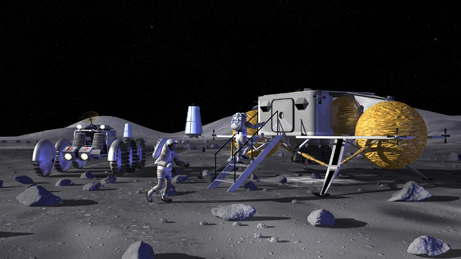IF civilisation is wiped out on Earth, salvation may come from space. Plans are being drawn up for a “Doomsday ark” on the moon containing the essentials of life and civilisation, to be activated in the event of earth being devastated by a giant asteroid or nuclear war.
Construction of a lunar information bank, discussed at a conference in Strasbourg last month, would provide survivors on Earth with a remote-access toolkit to rebuild the human race.
A basic version of the ark would contain hard discs holding information such as DNA sequences and instructions for metal smelting or planting crops. It would be buried in a vault just under the lunar surface and transmitters would send the data to heavily protected receivers on earth. If no receivers survived, the ark would continue transmitting the information until new ones could be built.
The vault could later be extended to include natural material including microbes, animal embryos and plant seeds and even cultural relics such as surplus items from museum stores.
As a first step to discovering whether living organisms could survive, European Space Agency scientists are hoping to experiment with growing tulips on the moon within the next decade.
According to Bernard Foing, chief scientist at the agency’s research department, the first flowers — tulips or arabidopsis, a plant widely used in research — could be grown in 2012 or 2015.
“Eventually, it will be necessary to have a kind of Noah’s ark there, a diversity of species from the biosphere,” said Foing.
Tulips are ideal because they can be frozen, transported long distances and grown with little nourishment. Combined with algae, an enclosed artificial atmosphere and chemically enhanced lunar soil, they could form the basis of an ecosystem.
Read the entire article at Times Online. See also “‘Lunar Ark’ Proposed in Case of Deadly Impact on Earth” on National Geographic.

Plans could be divided into a 20- and 50-years-project. The 20-years-project comes first. It brings hard disks and transmitters to the moon. So if the question what to do if no receivers survived can be solved before the end of the 1st project, the 50-years-project should begin earlier than in 20 years. Tulips can be planted within the 50 years project. When people rush things like the research on biospheres on the moon, they loose opportunities which are needed to make the ark really secure.
Why not put a few here on Earth?
Some redundancy in this regard would be desirable.
Five hard disks, four different engines for space craft, three robots, two receivers, one rocket. That’s an equipment which leaves opportunities for more. A few information banks on earth may be added after the robots have accomplished their tasks on the moon. Better construct these robots now and try further research later.